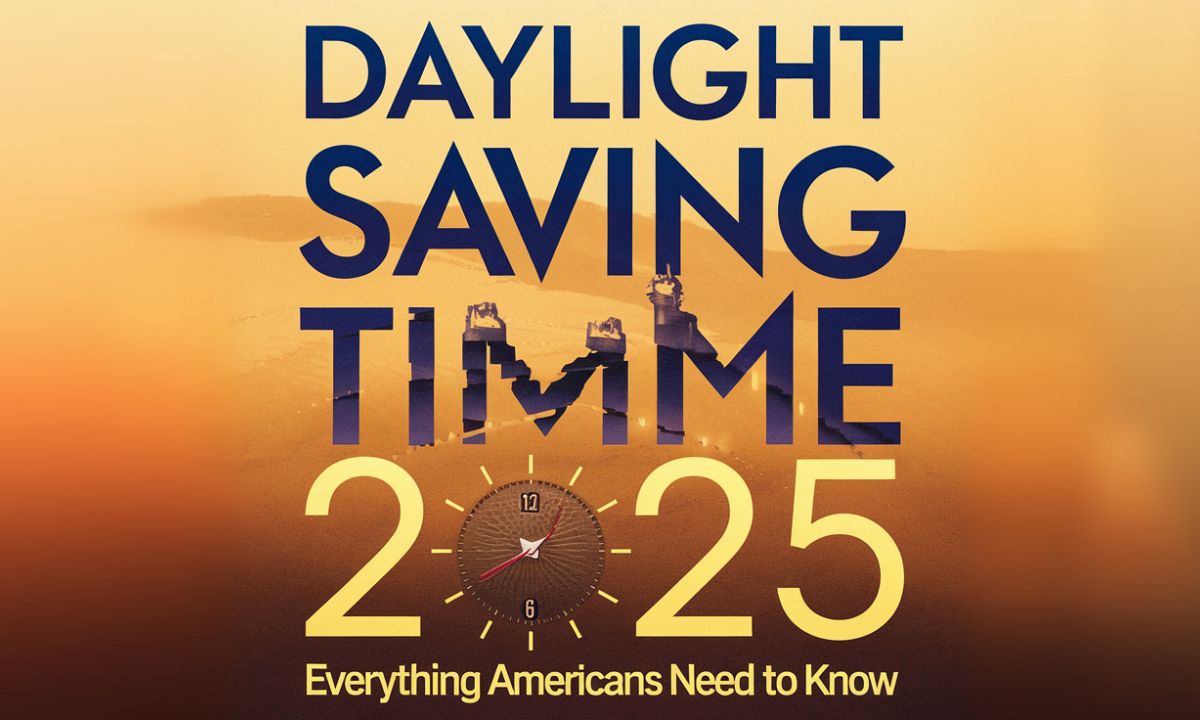As we approach another year of changing our clocks, many Americans find themselves asking the same questions: When exactly does Daylight Saving Time happen in 2025? Why do we still do this? And will this tradition continue much longer?
This comprehensive guide to Daylight Saving Time 2025 will answer all your questions and help you prepare for both the spring and fall time changes.
The Basics of Daylight Saving Time
Daylight Saving Time (DST) is the practice of advancing clocks forward by one hour during warmer months so that darkness falls later in the day. Despite the common misnomer “Daylight Savings Time” (with an ‘s’), the correct term is actually Daylight Saving Time – think of it as saving daylight, not a savings account for daylight.
The history of DST in America is fascinating and somewhat complicated. While Benjamin Franklin is often credited with the concept, he merely suggested Parisians could save candles by getting up earlier – he never proposed changing the clocks. Modern DST was first implemented during World War I as an energy-saving measure, but it wasn’t standardized in the United States until the Uniform Time Act of 1966. Since then, the start and end dates have shifted several times, most recently in 2007 when the Energy Policy Act of 2005 extended DST by about a month.
“Daylight Saving Time is a prime example of how seemingly simple policy changes can have complex and far-reaching effects on daily life.” – Dr. David Prerau, author of “Seize the Daylight”
Not every state participates in this biannual ritual. Hawaii and most of Arizona (with the exception of the Navajo Nation) don’t observe DST. These states remain on standard time year-round, primarily due to their abundant sunshine and warm climates that make extra evening daylight less necessary. Several U.S. territories including Puerto Rico, the U.S. Virgin Islands, American Samoa, and Guam also don’t participate in the time change.
Daylight Saving Time 2025 Key Dates
Mark your calendars for these important dates in 2025:
| Event | Date | Action |
| Spring Forward | Sunday, March 9, 2025, 2:00 AM | Move clocks forward one hour |
| Fall Back | Sunday, November 2, 2025, 2:00 AM | Move clocks backward one hour |
The easiest way to remember which direction to adjust your clocks is with the simple phrase: “spring forward, fall back.” In spring, we move our clocks forward, losing an hour; in fall, we move them back, gaining an hour.
These changes don’t happen simultaneously across the country due to different time zones. When it’s 2:00 AM in the Eastern Time Zone, it’s only 11:00 PM in the Pacific Time Zone. However, all regions make the switch at 2:00 AM in their local time zone.
How DST Will Impact Your Life in 2025
The shift to Daylight Saving Time in March 2025 will have noticeable effects on daily life across America. When we spring forward, many people experience a temporary but significant disruption to their sleep patterns. Research from the American Academy of Sleep Medicine shows that the transition to DST is associated with an average sleep duration reduction of 40 minutes, which can lead to increased sleepiness and decreased alertness for days or even weeks following the change.
The immediate impact of the March time change goes beyond just feeling tired. Studies have documented a 6% increase in fatal car accidents in the week following the spring transition. There’s also evidence of increased workplace injuries, reduced productivity, and even a slight uptick in heart attacks and strokes in the days immediately following the spring time change.
On the positive side, the extra evening daylight has significant benefits:
- Extended daylight for outdoor recreation and exercise
- Reduced energy consumption for lighting
- Potential reduction in crime rates during evening hours
- Economic boost for many businesses, particularly in tourism and retail
- Enhanced vitamin D exposure for many people
For the fall transition in November 2025, the effects are generally less disruptive. Many people enjoy the extra hour of sleep, though some still experience temporary disruption to their circadian rhythms. Parents of young children often find the fall transition challenging, as kids’ internal body clocks don’t immediately adjust to the new schedule.
Technology and Daylight Saving Time 2025
In our interconnected world, the technology aspect of Daylight Saving Time becomes increasingly relevant. Most digital devices now update automatically, but not all of them. Here’s a breakdown of what to expect:
Devices that typically update automatically:
- Smartphones and tablets
- Computers and laptops
- Smart watches
- Smart home devices (like Nest thermostats)
- Streaming devices (Roku, Apple TV, etc.)
- Modern cable boxes and satellite receivers
Devices you’ll likely need to update manually:
- Analog clocks and watches
- Car clocks (especially in older models)
- Microwaves and ovens
- Traditional alarm clocks
- Some programmable thermostats
- Many appliances with digital clocks
Tech glitches do sometimes occur during the time change. In 2010, a DST bug in the iPhone alarm clock caused many people to oversleep, and in 2016, some Fitbit users reported inaccurate sleep tracking during the transition. To avoid technology-related problems during the 2025 time changes, consider updating your device software a few days before the transition.
Several helpful apps can assist with the DST transition. Apps like “Time Buddy” help you track multiple time zones, while “Sleep Cycle” can help you gradually adjust your sleep schedule in the days leading up to the change.
The Ongoing Debate: Is 2025 the Last Year for DST?
The question of whether to continue the practice of changing clocks twice a year has gained significant momentum in recent years. The Sunshine Protection Act, which would make Daylight Saving Time permanent nationwide, passed the U.S. Senate unanimously in March 2022 but stalled in the House of Representatives. Various versions of similar legislation have been introduced since then.
As of late 2024, the federal government had not passed legislation to end the biannual clock changes, meaning that Daylight Saving Time 2025 will proceed as scheduled. However, many states have passed legislation expressing their desire to remain on either permanent standard time or permanent Daylight Saving Time if federal law allows it.
States that have passed legislation to stay on permanent Daylight Saving Time (pending federal approval):
- Alabama
- Colorado
- Delaware
- Florida
- Georgia
- Idaho
- Kentucky
- Louisiana
- Maine
- Minnesota
- Mississippi
- Montana
- Ohio
- Oregon
- South Carolina
- Tennessee
- Utah
- Washington
- Wyoming
Case Study: California’s DST Referendum
In 2018, California voters approved Proposition 7, which gave the state legislature authority to change the dates and times of Daylight Saving Time in California, including potentially making it permanent. However, the state still requires federal approval to implement such a change, and as of late 2024, no action had been taken.
The debate continues between those who favor permanent standard time (supported by many sleep scientists and health experts) and those who favor permanent Daylight Saving Time (generally preferred by the business community and recreation advocates).
How to Prepare for Daylight Saving Time Changes in 2025
To minimize disruption from the time changes in 2025, consider these preparation strategies:
For the Spring Forward (March 9, 2025):
- Adjust gradually – Start going to bed 15-20 minutes earlier for a few days before the change
- Maximize morning light exposure – Open curtains or use a light therapy box
- Limit evening screen time – Blue light can further disrupt sleep patterns
- Avoid extra caffeine – Particularly in the afternoon and evening
- Schedule important tasks for later in the week – Avoid critical work or driving when sleep-deprived
- Update devices in advance – Change manual clocks on Saturday evening
For the Fall Back (November 2, 2025):
- Use the extra hour productively – Many fire departments promote this as a good time to check smoke detector batteries
- Adjust gradually – Try pushing activities slightly later for a few days before
- Prepare for earlier darkness – Have reflective gear ready for evening outdoor activities
- Be mindful of child and pet schedules – They may wake earlier than usual
Device Update Checklist:
- Wall clocks
- Appliance clocks (microwave, oven, coffee maker)
- Car clocks
- Watches
- Alarm clocks
- Timers and programmable devices
Health and Safety During DST Transitions
The health effects of Daylight Saving Time transitions deserve special attention. Research consistently shows that the spring transition in particular can have measurable negative health impacts. A 2020 study published in the Journal of Clinical Sleep Medicine found a 6% increase in hospital admissions for atrial fibrillation in the week following the spring transition.
Traffic safety is another significant concern. The Monday after springing forward sees approximately a 6% increase in fatal car accidents, according to a study from the University of Colorado. This is attributed to both sleep deprivation and changed light conditions affecting visibility during commuting hours.
Sleep experts recommend these strategies to minimize health disruptions:
- Maintain consistent sleep habits – Go to bed and wake up at the same time every day, including weekends
- Create a sleep-friendly environment – Keep bedrooms dark, quiet and cool
- Limit alcohol and caffeine – Especially in the hours before bedtime
- Get regular exercise – But not too close to bedtime
- Manage stress – Try relaxation techniques like meditation or deep breathing
- Expose yourself to natural light – Particularly in the morning
Special consideration should be given to vulnerable populations during time changes. Children, older adults, and people with existing health conditions may experience more pronounced effects. Parents should gradually shift children’s bedtimes in 10-15 minute increments over several days. Caregivers of older adults should be vigilant about medication schedules during the transitions to ensure proper timing is maintained.
Conclusion
Daylight Saving Time 2025 will bring the familiar ritual of changing our clocks twice – forward on March 9 and back on November 2. While the practice remains controversial, understanding how to prepare can significantly reduce the negative impacts on your health, safety, and daily routine.
As debate continues about whether to make DST permanent, eliminate it entirely, or maintain the status quo, Americans will continue the biannual practice in 2025. Whether you’re a fan of the extra evening daylight or prefer consistency year-round, being prepared for the transitions will help you make the most of Daylight Saving Time 2025.
Remember the key dates: Spring forward on Sunday, March 9, 2025, and fall back on Sunday, November 2, 2025. Mark your calendars now, and consider setting a reminder a few days in advance to begin your transition preparations.
Frequently Asked Questions About Daylight Saving Time 2025
Why do we still have Daylight Saving Time? The continuation of DST is primarily due to a combination of tradition, perceived energy benefits, and support from various business sectors that benefit from extra evening daylight. While energy savings were the original justification, modern studies show minimal energy benefits.
Does the entire United States observe DST? No. Hawaii, most of Arizona (excluding the Navajo Nation), and the U.S. territories of Puerto Rico, the U.S. Virgin Islands, American Samoa, and Guam do not observe Daylight Saving Time.
How did Daylight Saving Time begin? Modern DST was first implemented during World War I as an energy conservation measure. It became standardized in the United States with the Uniform Time Act of 1966.
What would permanent DST or permanent standard time mean? Permanent DST would mean keeping the “summer” time year-round, with later sunsets but also later sunrises in winter. Permanent standard time would maintain the “winter” time throughout the year, with earlier sunrises and earlier sunsets during summer months.
Is it “Saving” or “Savings” Time? The official term is Daylight Saving Time (no “s”), though “Savings” is commonly used in everyday speech.
How does DST affect farmers? Contrary to popular belief, the agricultural sector has historically opposed DST. Farmers’ schedules are largely dictated by daylight and animal needs, not clock time. The time change can disrupt established routines for both farmers and livestock.










